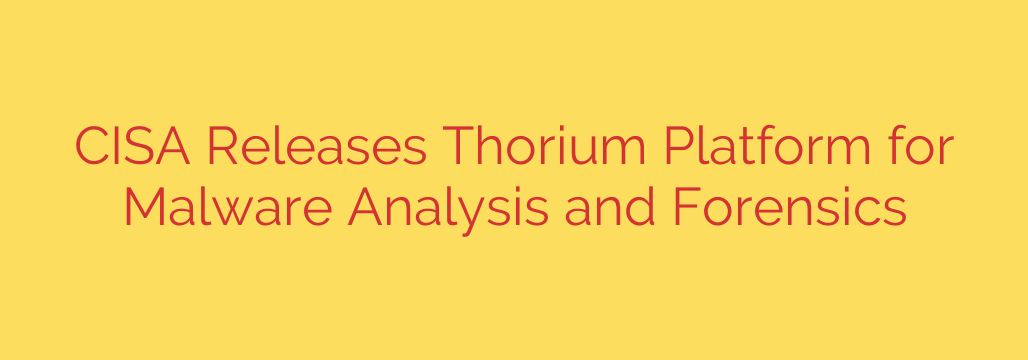
A Game-Changer for Cybersecurity: U.S. Government Launches Powerful Open-Source Malware Analysis Platform
In a significant move to bolster national cyber defenses, a leading U.S. cybersecurity agency has officially launched a powerful new platform designed for advanced malware analysis and digital forensics. This tool, known as Thorium, is set to provide cybersecurity professionals with a robust, automated solution for dissecting and understanding complex digital threats.
The release marks a pivotal moment for public-sector security teams, offering them access to sophisticated analysis capabilities that were previously complex or costly to deploy. By leveraging the power of open-source technology, this platform democratizes high-level threat analysis, empowering a wider range of defenders to protect critical infrastructure.
What is the Thorium Platform?
Thorium is a cloud-hosted malware analysis platform that functions as a secure “sandbox.” In cybersecurity, a sandbox is an isolated, controlled environment where potentially malicious code can be safely executed and observed. Analysts can submit suspicious files to the platform, which then “detonates” the malware to see exactly what it does—what files it creates, what network connections it attempts, and what changes it makes to a system.
This detailed observation provides invaluable intelligence for incident response, threat hunting, and developing effective countermeasures. The platform is specifically designed to automate much of this complex analysis, delivering comprehensive reports that break down a malware sample’s behavior, capabilities, and indicators of compromise (IOCs).
Key Features and Capabilities
The platform is built on a foundation of trusted and well-regarded open-source tools, integrating them into a single, user-friendly interface. This approach ensures transparency and leverages the collective strength of the global security community.
Key features include:
- Automated Static and Dynamic Analysis: Thorium examines malware from two angles. Static analysis inspects the code without running it, looking for suspicious strings and structures. Dynamic analysis, the sandbox component, runs the code to observe its real-world behavior.
- Comprehensive Reporting: After an analysis, the platform generates a detailed report that includes extracted IOCs (like file hashes, IP addresses, and domains), behavioral patterns, and screenshots of the malware in action.
- Mapping to MITRE ATT&CK®: Crucially, the platform maps observed malware behaviors to the industry-standard MITRE ATT&CK framework. This helps analysts understand the specific tactics, techniques, and procedures (TTPs) the threat actor is using, providing a clear picture of the attack lifecycle.
- Broad File Support: It is engineered to handle a wide variety of malicious file types, including Windows executables (PE files), DLLs, documents with macros, and shellcode.
- Secure Cloud Environment: Hosted in a secure government cloud environment, the platform ensures that analysis is contained and that sensitive threat data is protected. This also means partners can access it without needing to procure and manage their own complex on-premise hardware.
Who Can Benefit and Why It Matters
Initially, this platform is being made available to U.S. federal, state, local, tribal, and territorial (SLTT) government partners, as well as other public and private sector organizations involved in critical infrastructure defense.
The launch of this tool is a strategic enhancement to the nation’s collective cybersecurity posture. By providing a standardized, powerful analysis tool, it enables faster and more consistent threat analysis across different government agencies and security teams. An organization in one state can analyze a new threat and the resulting intelligence can be rapidly shared, helping others prepare for or identify the same attack.
This levels the playing field, giving under-resourced security teams access to enterprise-grade tools that can help them effectively combat sophisticated adversaries.
Actionable Security Tips for Your Organization
While direct access to this government platform may be limited, its release underscores the importance of proactive malware analysis and defense. Here are key steps every organization should take to bolster its security:
- Implement Layered Defenses: Don’t rely on a single security product. A combination of a modern firewall, email security gateway, and an advanced Endpoint Detection and Response (EDR) solution is essential for catching threats at different stages.
- Foster a Culture of Security: Train employees to be the first line of defense. Regular training on identifying phishing emails, suspicious links, and malicious attachments can prevent a significant number of security incidents.
- Prioritize Patch Management: Threat actors frequently exploit known vulnerabilities in software. Ensure you have a robust process for applying security patches to operating systems, web browsers, and other critical applications as soon as they become available.
- Develop an Incident Response Plan: Don’t wait for an attack to figure out what to do. Have a clear, documented plan that outlines who to contact, what steps to take, and how to isolate affected systems to minimize damage.
The introduction of this new analysis platform represents a major step forward in the public-private fight against cybercrime. By empowering defenders with better tools and more detailed intelligence, we can build a more resilient and secure digital ecosystem.
Source: https://www.bleepingcomputer.com/news/security/cisa-open-sources-thorium-platform-for-malware-forensic-analysis/








